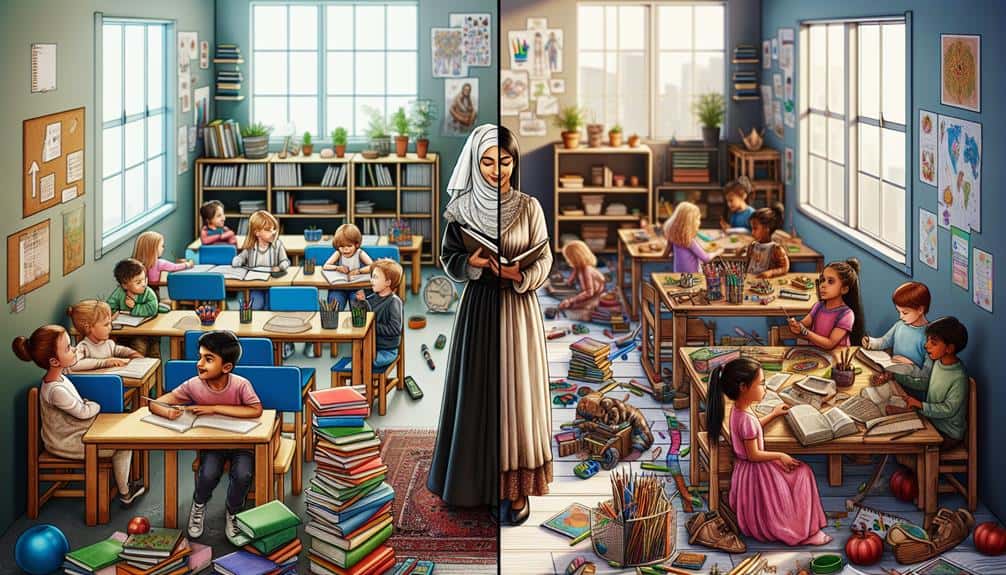Discover the essence of Waldorf homeschooling curriculum, centered on holistic education tailored for child-centric learning. Immerse yourself in hands-on activities, art, music, nature exploration, and rich storytelling traditions. Uncover the magic of blending nature, creativity, and sensory exploration in your homeschooling journey. Engage in arts, crafts, and folktales to foster critical thinking, creativity, and fine motor skills. Embrace the importance of practical learning, enhancing comprehension through real-world applications. Start your exploration of music, movement integration, and seasonal celebrations to create a harmonious learning environment. Access the full potential of Waldorf homeschooling curriculum in a holistic and enriching way.
Key Points
- Incorporate nature journaling for observation skills and ecological understanding.
- Integrate arts and crafts into subjects for creativity and fine motor skills.
- Utilize storytelling and folktales to broaden cultural perspectives.
- Implement hands-on activities for practical learning and improved retention.
- Integrate music and movement for sensory exploration and community building.
Waldorf Homeschooling Philosophy Overview
Explore the foundational principles and beliefs that form the Waldorf homeschooling philosophy. Waldorf education is centered around holistic education, focusing on the development of the whole child – mind, body, and spirit. The child-centered approach in Waldorf homeschooling emphasizes nurturing each child's unique talents and capabilities, fostering a love for learning that lasts a lifetime.
Experiential learning is at the core of Waldorf philosophy, where children learn through hands-on experiences and sensory exploration. This approach allows children to engage with the material in a meaningful way, making learning more effective and enjoyable. By incorporating activities that stimulate all the senses, children are more likely to retain information and develop a deeper understanding of the subject matter.
In Waldorf homeschooling, the emphasis isn't just on academic achievement but also on fostering creativity, critical thinking, and emotional intelligence. By providing a rich and varied curriculum that includes art, music, movement, and nature-based activities, children are encouraged to explore their interests and develop a well-rounded set of skills.
Incorporating Nature in Curriculum
In Waldorf homeschooling curriculum, nature plays a crucial role in enriching learning experiences and fostering a deeper connection to the environment. Incorporating nature into your curriculum can be achieved through activities like nature journaling and outdoor exploration.
Nature journaling involves recording observations, sketches, and thoughts about the natural world, encouraging children to pay close attention to the details of their surroundings. This practice not only enhances their writing and artistic skills but also cultivates a sense of wonder and appreciation for the beauty of nature.
Outdoor exploration is another essential aspect of incorporating nature into the curriculum. Spending time outdoors allows children to engage with the natural environment firsthand, stimulating their senses and curiosity. It provides opportunities for hands-on learning experiences, such as identifying different plants and animals, observing seasonal changes, and understanding ecological concepts in a tangible way.
Arts and Crafts in Learning
When exploring the Waldorf homeschooling curriculum, you'll find that arts and crafts play a crucial role in enhancing your child's education.
Creative expressions are integrated into various subjects, allowing hands-on learning activities that foster a deeper understanding of concepts.
Through artistic development in the curriculum, children are encouraged to engage in imaginative and tactile experiences that support their overall growth and learning.
Creative Expressions in Education
Engaging in arts and crafts within the Waldorf homeschooling curriculum fosters creativity, critical thinking, and fine motor skills in young learners. In addition to traditional arts and crafts activities, Waldorf education incorporates drama workshops and poetry readings to enhance creative expressions in education.
Drama workshops provide a platform for children to explore emotions, storytelling, and character development. Through role-playing and improvisation, students can develop communication skills and build confidence in expressing themselves. These workshops encourage imagination and empathy while fostering a sense of collaboration among peers.
Poetry readings offer a gateway into the world of language and emotions. By engaging with various poetic forms and styles, students can deepen their understanding of self-expression and language nuances. Analyzing and reciting poems allow children to appreciate the beauty of words and rhythm, enhancing their linguistic capabilities.
Hands-On Learning Activities
Regularly incorporating hands-on arts and crafts activities into your homeschooling curriculum can enhance your child's creativity, critical thinking skills, and fine motor abilities. Engaging in sensory exploration through activities like painting, sculpting, or crafting with natural materials allows your child to learn through touch, sight, and sound, stimulating multiple senses simultaneously.
Outdoor adventures provide a dynamic setting for hands-on learning, fostering a deeper connection to nature and promoting physical activity. Encouraging your child to collect leaves for a nature-inspired collage or create a bird feeder from recycled materials combines creativity with environmental awareness.
Through arts and crafts, your child can develop problem-solving skills by experimenting with different materials and techniques, encouraging them to think outside the box. These activities also promote emotional well-being, providing a therapeutic outlet for self-expression.
Artistic Development in Curriculum
Incorporating arts and crafts activities into your homeschooling curriculum can greatly enhance your child's artistic development and overall learning experience. Engaging in artistic exploration and creative expression through visual arts fosters imaginative development in children.
Here are five key benefits of integrating arts and crafts into your homeschooling routine:
- Enhanced Fine Motor Skills: Activities like drawing, coloring, and crafting help refine hand-eye coordination and dexterity.
- Cultivation of Creativity: Encouraging your child to experiment with different materials and techniques sparks their creativity and nurtures self-expression.
- Improved Problem-Solving Abilities: Art projects often require critical thinking and decision-making, promoting problem-solving skills in a fun and engaging way.
- Boost in Confidence: Completing art projects and seeing tangible results can build your child's self-esteem and confidence in their abilities.
- Emotional Expression: Art provides a safe space for children to express their feelings and emotions through colors, shapes, and textures.
Emphasis on Storytelling and Folktales
Throughout the Waldorf homeschooling curriculum, storytelling and folktales play a central role in fostering creativity and imagination in children. Folklore exploration is a key component, with stories from around the world used to engage young minds. By immersing children in diverse cultural narratives, Waldorf education aims to broaden their perspectives and promote empathy.
Storytelling techniques in Waldorf homeschooling often involve oral traditions, where educators narrate tales with expressive gestures and voice modulation to captivate their audience. This interactive approach not only enhances listening skills but also encourages children to use their imagination to visualize the unfolding story.
Additionally, folktales are integrated into various subjects, such as language arts and social studies, allowing students to explore different themes and moral lessons embedded in these traditional stories. By connecting with age-old narratives, children not only develop a love for storytelling but also gain a deeper understanding of the values shared across cultures.
Importance of Hands-On Activities
Hands-On activities play a vital role in the Waldorf homeschooling curriculum. They provide numerous benefits by allowing you to engage in practical applications of concepts learned.
These kinesthetic experiences enhance your understanding of subjects through hands-on learning.
Hands-On Learning Benefits
Engaging in interactive activities fosters a deeper understanding of concepts in the Waldorf homeschooling curriculum. Hands-on learning brings a unique set of benefits that cater to different learning styles and enhance overall comprehension. Through sensory stimulation and tactile exploration, students can grasp complex ideas with ease.
Here are five key advantages of incorporating hands-on activities:
- Enhanced Retention: By physically engaging with materials, students are more likely to remember information for longer periods.
- Improved Problem-Solving Skills: Hands-on tasks encourage critical thinking and allow learners to apply theoretical knowledge to practical situations.
- Boosted Creativity: Creative expression is heightened when children can manipulate objects and experiment freely.
- Increased Engagement: Active participation maintains focus and interest, leading to a more dynamic learning experience.
- Development of Fine Motor Skills: Handling various tools and materials contributes to the refinement of fine motor abilities.
Incorporating hands-on learning into the Waldorf homeschooling curriculum not only solidifies understanding but also nurtures holistic growth in students.
Practical Application Activities
Exploring practical application activities within the Waldorf homeschooling curriculum allows students to directly apply theoretical knowledge in real-world contexts, fostering a deeper understanding of concepts through hands-on engagement.
Sensory exploration plays an essential role in these activities, encouraging students to engage their senses of touch, sight, smell, and even taste to enhance their learning experience. Through sensory-rich tasks like baking bread, gardening, or crafting, students not only grasp concepts intellectually but also develop a profound connection to the subject matter.
Outdoor adventures further complement these practical activities by providing students with opportunities to learn in natural settings. Whether it's studying plant life in a forest, observing animal behavior in a park, or conducting experiments near a stream, outdoor experiences offer a dynamic learning environment that stimulates curiosity and exploration.
Engaging in hands-on activities outdoors not only reinforces academic concepts but also nurtures a sense of wonder and appreciation for the natural world.
Engaging Kinesthetic Experiences
Utilizing kinesthetic experiences in the Waldorf homeschooling curriculum fosters a dynamic learning environment where students actively engage with the material through physical interaction and movement. This hands-on approach not only caters to different learning styles but also enhances sensory exploration, making learning more immersive and memorable.
Incorporating movement activities into lessons allows students to connect with the subject matter on a deeper level, fostering creativity and critical thinking skills. Here are five ways kinesthetic experiences benefit the Waldorf homeschooling curriculum:
- Enhanced Understanding: Moving while learning helps solidify concepts and improve retention.
- Physical Health: Engaging in movement activities promotes physical well-being and a balanced lifestyle.
- Creativity Boost: Kinesthetic experiences stimulate creativity and inspire innovative thinking.
- Improved Focus: Physical engagement can help students stay focused and attentive during lessons.
- Emotional Connection: Hands-on activities create emotional connections to the material, making learning more meaningful.
Music and Movement Integration
Incorporating music and movement into your Waldorf homeschooling curriculum enhances learning experiences and fosters holistic development in children. Rhythm and dance play an essential role in Waldorf education, encouraging children to express themselves creatively while developing coordination and motor skills.
Through rhythmic activities like clapping, stomping, or playing simple instruments, children engage in sensory exploration, honing their auditory and tactile senses.
Integrating music into lessons can create a harmonious atmosphere conducive to learning. You can incorporate songs into daily routines, use music to signal shifts between activities, or even explore different genres and cultures through musical experiences.
Movement activities, such as circle dances or yoga, not only enhance physical well-being but also promote a sense of community and cooperation among children.
Celebrating Festivals and Seasons
As you progress through your Waldorf homeschooling journey, embracing the rich tapestry of festivals and seasons becomes a vibrant thread weaving through your educational experiences. Celebrating festivals and seasons in a Waldorf homeschooling curriculum offers a unique opportunity to connect with nature, foster creativity, and cultivate a sense of community. Here are some key aspects to ponder:
- Seasonal Traditions: Engage in age-old customs and rituals that mark the changing seasons, such as creating seasonal nature tables or participating in harvest festivals.
- Nature-Inspired Crafts: Utilize materials found in nature to create beautiful crafts that reflect the seasonal changes, like making leaf rubbings or crafting bird feeders.
- Festive Celebrations: Embrace festivals like Michaelmas, Martinmas, or Winter Spiral Walks, each carrying its own significance and opportunities for celebration.
- Outdoor Activities: Take learning outside with activities like nature walks, gardening, or seasonal scavenger hunts, immersing in the natural world around you.
- Community Connections: Join with other homeschooling families or local groups to celebrate festivals together, fostering a sense of belonging and shared experiences.
Frequently Asked Questions
How Can I Adapt the Waldorf Curriculum for Multiple Children of Different Ages?
In your Waldorf homeschool, think of yourself as a conductor orchestrating a symphony. Tailor lessons to each child's needs, blending individualized tasks with group projects. Adjust schedules to suit ages, fostering a harmonious learning environment.
Are There Any Resources for Finding Waldorf-Inspired Educational Materials?
You can discover Waldorf-inspired educational materials by exploring online shops like Etsy or Bella Luna Toys. These resources offer a variety of nature-based learning tools, such as Waldorf-inspired crafts and materials that align with the Waldorf philosophy.
What Role Do Parents Play in Waldorf Homeschooling Beyond Teaching?
Parental involvement in Waldorf homeschooling extends beyond teaching. Did you know that 92% of parents engage in artistic activities with their children? This holistic approach encourages creativity, collaboration, and a deep connection to learning.
Can I Incorporate Technology or Digital Resources Into the Waldorf Curriculum?
You can incorporate technology or digital resources into the Waldorf curriculum, but it's essential to maintain a balance that aligns with Waldorf principles. Use digital tools sparingly to supplement, not replace, hands-on, nature-based learning experiences central to Waldorf education.
How Can I Connect With Other Waldorf Homeschooling Families for Support and Collaboration?
Looking to deepen your Waldorf homeschooling journey? Online communities offer a wealth of wisdom and camaraderie. To expand connections further, consider joining local meetups where you can share experiences, resources, and forge lasting friendships.



